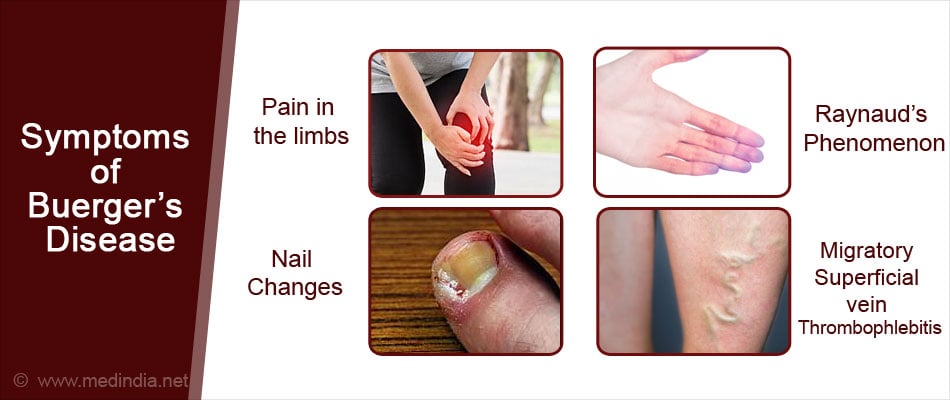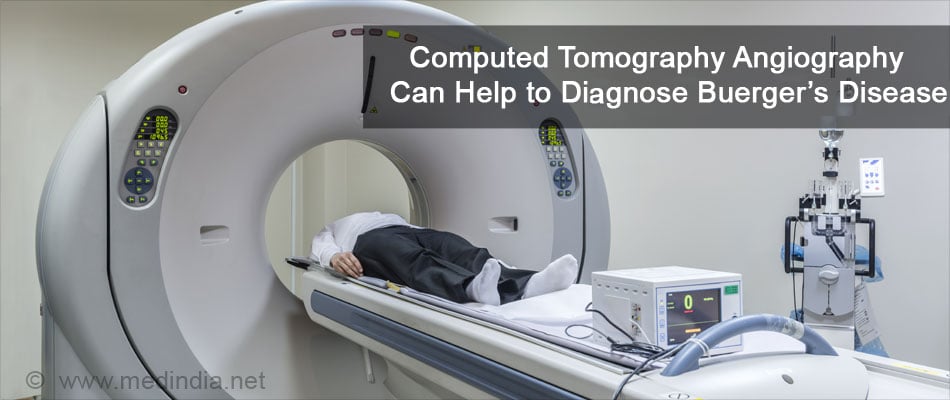- Buergers Disease - (https://www.cdc.gov/tobacco/campaign/tips/diseases/buergers-disease.html)
- Types of Vasculitis - (https://www.nhlbi.nih.gov/health/health-topics/topics/vas/types)
- Harrison’s Principles of Internal Medicine 19th edition
- Thromboangiitis Obliterans (Buerger's Disease)-Current Practices - (http://dx.doi.org/10.1155/2013/156905)
- Arkkila PET. Thromboangiitis obliterans (Buerger''s disease). Orphanet Journal of Rare Diseases20061:14 DOI: 10.1186/1750-1172-1-14
What is Buerger's Disease?
Buerger's disease or thromboangiitis obliterans is a condition characterized by inflammation and clot formation in the small and medium-sized blood vessels including arteries and veins.
It reduces the blood supply to the hands and feet, and the forearms and legs. The blood vessels supplying to the brain, heart and other organs may also be rarely affected.
What are the Causes of Buerger's Disease?
Though several mechanisms have been suggested, the exact cause of Buerger’s disease is not known. Smoking is considered as the most important risk factor of Buerger’s disease. Buerger’s disease particularly affects those who smoke more than one and a half packs a day. Other forms of tobacco like chewing tobacco have also been associated with Buerger's disease.

Other risk factors for Buerger’s disease include:
- It is more common in males. However, the increased incidence of Buerger’s disease in women in the recent years may be reflective of more women taking up smoking.
- Younger age group between 20 and 40 years.
- Asians and people of East European descent.
What are the Symptoms of Buerger's Disease?
Symptoms of Buerger’s disease include the following:
- Pain in the limbs that first appears with activity, and later may appear even at rest as the disease progresses. Pain appears in the calf or foot if the lower limb is affected, or the forearms or hands if the upper limbs are affected. The person typically gives a history of pain in the legs that comes on after walking forcing him to stop and rest every few minutes.
- Raynaud’s phenomenon, a condition caused by altered blood flow in the fingers or toes when exposed to temperature changes or during emotional conditions. The blood supply first reduces, making the fingers pale, which later turn blue due to depletion of oxygen. This is followed by a rush of blood into the digits, making them red in color. The patient may also experience pain, tingling and numbness in the digits during the episodes.
- Cold hands or feet
- Nail changes, ulceration, infection and gangrene of the fingers and toes. Gangrene is the death and decay of tissues, which appear black
- Migratory superficial vein thrombophlebitis, characterized by recurrent episodes of localized pain and redness over the veins that shifts from one limb to another

In rare cases, the following may be present:
- Abdominal pain, diarrhea, weight loss, blood in stool or intestinal perforation, if the blood vessels of the digestive tract are affected
- Transient ischemic attacks or stroke if the brain is affected
- Heart attack if the blood vessels to the heart are affected
Some patients may report transient arthritis of large joints like the wrist or knees around ten years before the appearance of Buerger's disease.
How do you Diagnose Buerger's Disease?
Buerger’s disease is diagnosed based on the following:
- History and physical examination of the patient. The pulses in the forearms, hands, lower parts of the legs and feet may be absent but the pulses in the upper parts of the upper and lower limbs are normal
- Blood tests to rule out other causes of vasculitis like autoimmune diseases as well as diabetes
- Imaging tests like magnetic resonance angiography (MRA), computed tomography angiography (CTA) and conventional arteriography to check the patency of blood vessels. The tests should be conducted in all four limbs, even if symptoms are not evident in all the limbs, since it could help in early detection of the mildly affected limbs. In Buerger's disease, the angiograms show:

- Localized areas of blockages of small and medium sized-blood vessels
- Absence of atherosclerosis in the affected blood vessels
- Collateral blood circulation develops around the occluded areas of the blood vessels
- Echocardiography, to ensure that the clots do not arise in the heart
- Biopsy of the affected vessel, which can confirm the diagnosis of Buerger’s disease
Buerger's disease is differentiated from other similar conditions based on the following:
- It affects young males more commonly
- It affects individuals consuming tobacco
- The symptoms are usually located only in the forearms and hands, and lower parts of the legs and feet
- Acute-phase reactants such as erythrocyte sedimentation rate (ESR) and C-reactive protein (CRP), and immunological markers like circulating immune complexes, and autoantibodies such as antinuclear antibody and rheumatoid factor, and complement levels and normal or absent in the blood
- A biopsy of the affected part of the blood vessel shows excess inflammation in the blood clot but the blood vessel wall is relatively spared, and the internal elastic lamina is preserved. A later stage may show recanalization of the blood vessels
How do you Treat Buerger's Disease?
There is no specific treatment for Buerger’s disease. The patient is advised to quit smoking and should be provided guidance regarding methods for the same. Nicotine patches and gums should not be used. Though the symptoms may not be completely reversed, the risk for amputation is reduced in those who stop smoking.
Several medications that have been tried which may reduce pain but usually do not affect the disease process. These include the following:
- Anti-platelet drugs like aspirin and clopidogrel to prevent clotting of blood
- Calcium channel blockers like verapamil to increase oxygen supply to the affected part
- Pentoxifylline reduces blood viscosity and improves blood flow through the narrowed blood vessels.
- Cilostazol which prevents blood clotting and relaxes blood vessels. It has been associated with several side effects
Antibiotics are used to treat infected ulcers. The gangrenous area is treated with local debridement. Amputation may be required in some cases. Other surgical procedures that could provide relief include the following:
- Surgical re-vascularization to increase blood supply to the deprived part, but it is usually not effective
- Sympathectomy, where the nerves that constrict the blood vessels are cut, thereby increasing blood flow to the affected part
- Ilizavor’s technique, where a gradual tension is applied to the tissue to promote growth and regeneration
- Spinal cord stimulators to reduce pain and increase blood supply to the affected limb
How do you Prevent Buerger's Disease?
Since tobacco is the principal risk factor of Buerger’s disease, it is essential to avoid all forms of tobacco including tobacco used for chewing. Besides avoiding smoking, exposure to second hand smoke should also be avoided.

Health Tips
Once a limb is affected, it is important to protect it to prevent worsening of symptoms:
- Injury to the affected feet should be avoided by using proper shoes
- Exposure to cold should be avoided
- Drugs that reduce blood supply to the affected part should be avoided










